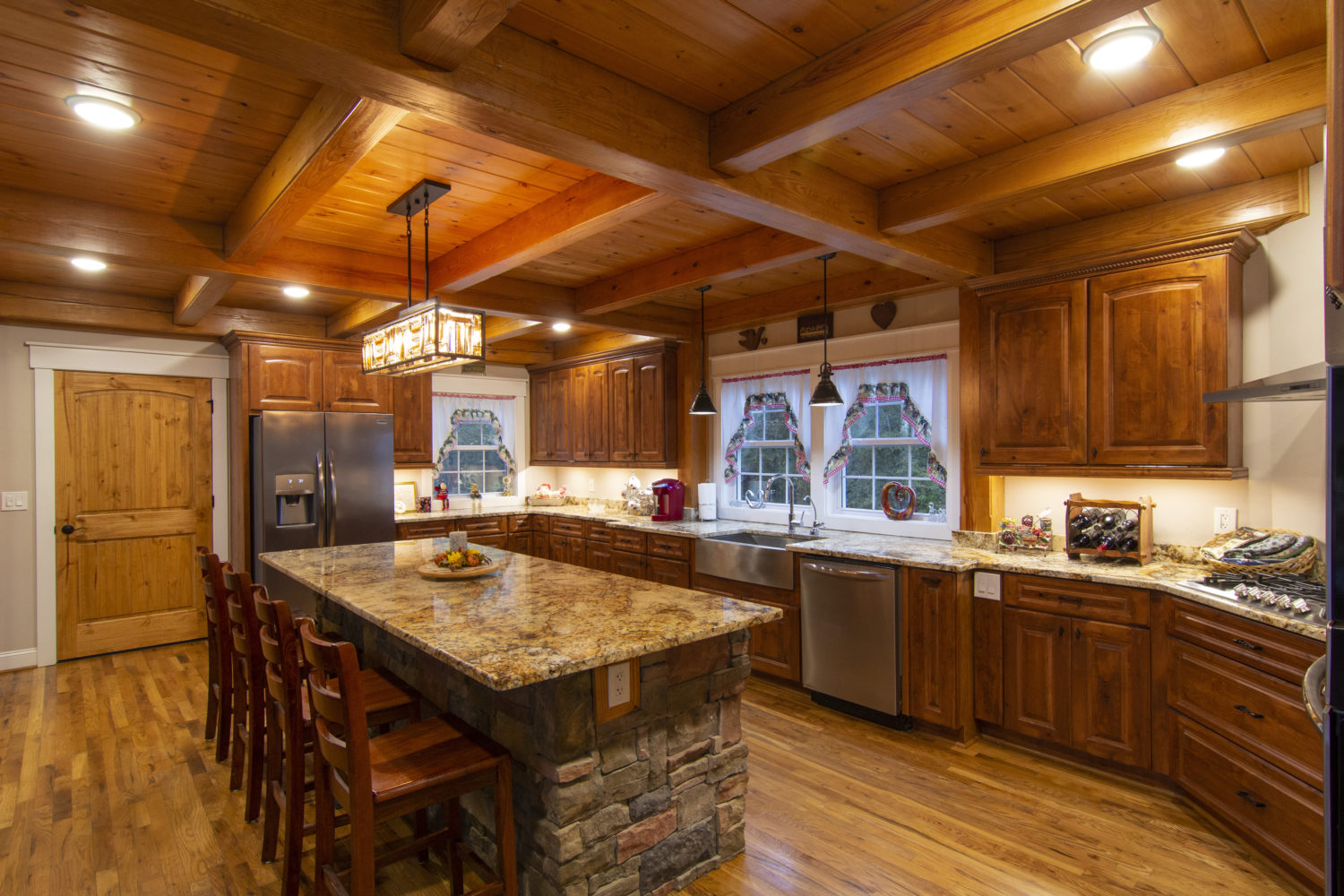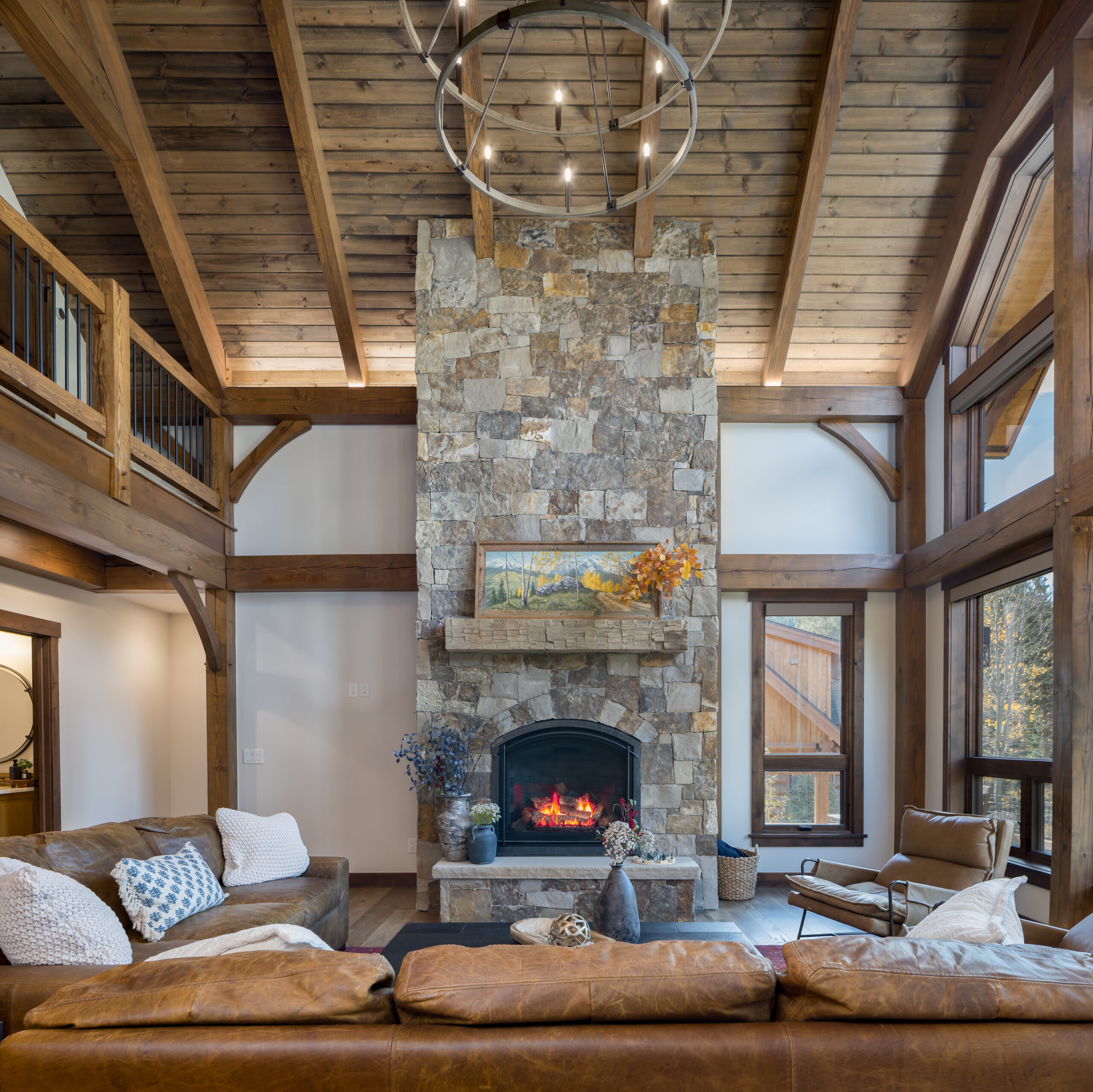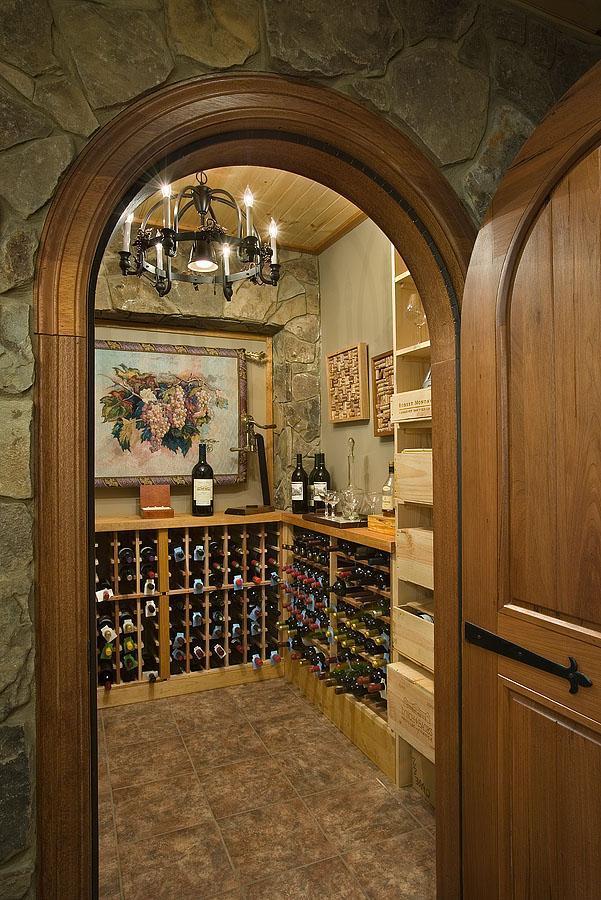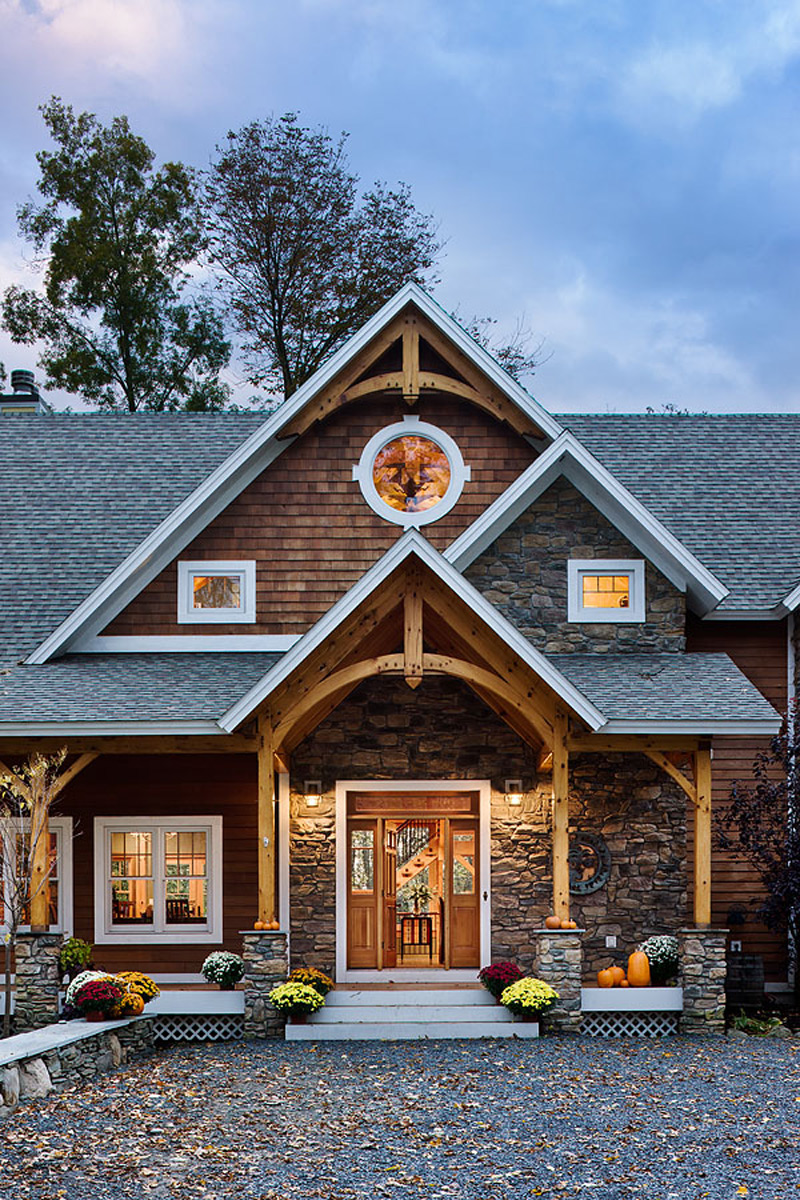Stone and timber are a powerful architectural pair; both introduce strength, beauty, and authenticity. Find out how they work together, learn a few key terms that will help you express your vision, and explore creative uses across a range of styles.
When you picture your dream timber frame home, chances are it’s not just the exposed beams that draw you in—it’s the earthy richness, the grounded warmth, the way natural materials connect the home to its environment with intention and authenticity. Take a close look through our gallery, and you’ll notice a recurring design element: stone. From foundations to chimneys, fireplaces, and entryways — stone is deliberately used as an anchor to create a depth and permanence that elevates the entire design.
When it comes to choosing stone, small details make all the difference in achieving the look you want. Whether you prefer a rugged mountain lodge, a sleek modern retreat, or something in between, understanding key terms like dry stack, veneer, river rock, and ledgestone will help you communicate your vision clearly and confidently.
In this post, we’ll break down the essentials: why stone is such a natural fit for timber frame homes, the terminology you’ll want in your back pocket when working with designers and builders, and examples of how stone can shift styles to suit any aesthetic, from classic rustic to clean contemporary.
Understanding Stone Terms
Choosing the right stone starts with speaking the language. Here’s a quick guide to essential terms that will help you communicate clearly with your design team:
- Stacked Stone: Thin, horizontal layers for a clean, linear look.
- River Rock: Smooth, rounded stones that bring a soft, organic feel.
- Ledgestone: Rough, layered stone with natural texture.
- Veneer: A thin stone layer applied over surfaces, saving weight and cost while preserving authenticity.
- Dry Stack: Stones laid without visible mortar for a natural, handcrafted appearance.
- Manufactured (or “Cultured”): Engineered to mimic natural stone, offering consistency and design flexibility.
Knowing the difference between natural and manufactured stone helps you weigh the unique variation of real stone against the lighter weight and uniformity of manufactured options. And how stone is applied matters: Veneer creates a slim surface layer, while dry stack emphasizes a rustic, mortar-free look. And it’s worth noting that both stone veneer and manufactured (or cultured) stone are used to reduce the weight on the structure beneath it.
Design Tips for Pairing Stone and Timber
If you’ve ever wondered why stone feels so timeless in a timber frame home, it’s because getting the balance just right makes all the difference. Stone and timber work beautifully together when you:
- Match the scale: Big, bold stone features call for equally strong timber beams. It’s all about keeping the balance so neither material overwhelms the other.
- Go local or reclaimed: Using stone sourced nearby—or reclaimed stone—not only looks great but also connects your home to its region and supports sustainability.
- Think about lighting: Good lighting can highlight both stone and wood, making those natural details pop.
- Pick the right finish: Whether it’s a rough split face, a smooth honed surface, or a tumbled look, the finish you choose should complement your timber style—think hand-hewn beams with rough stone or sleek beams with a polished veneer.
These little details help create a space that feels authentic, inviting, and uniquely yours.
How to Apply Stone to Any Style or Space
Stone’s versatility suits nearly every style and space. It strengthens foundations, enhances curb appeal, and creates spa-like bathrooms with stone tile surrounds. Fireplaces gain character through ledgestone or dry stack, while kitchens benefit from stone backsplashes and island accents. Columns or garden walls help unify your property’s aesthetic. You might be surprised by the many ways stone can bring visual interest to all kinds of designs:
- In modern homes, thin stacked stone or smooth veneer adds subtle complexity without disrupting clean lines.
- Rustic homes benefit from grand chimneys and detailed stacked facades, which evoke looks of the past and ground the home in timeless character.
- Mid-century homes often use smooth river rock or flat ledgestone accents to complement wood and open spaces.
- In commercial timber frame spaces—like lodges, sanctuaries, wineries, or offices—stone adds lasting character and a sense of place. It elevates entries, accent walls, and gathering areas while reinforcing a warm, grounded aesthetic.
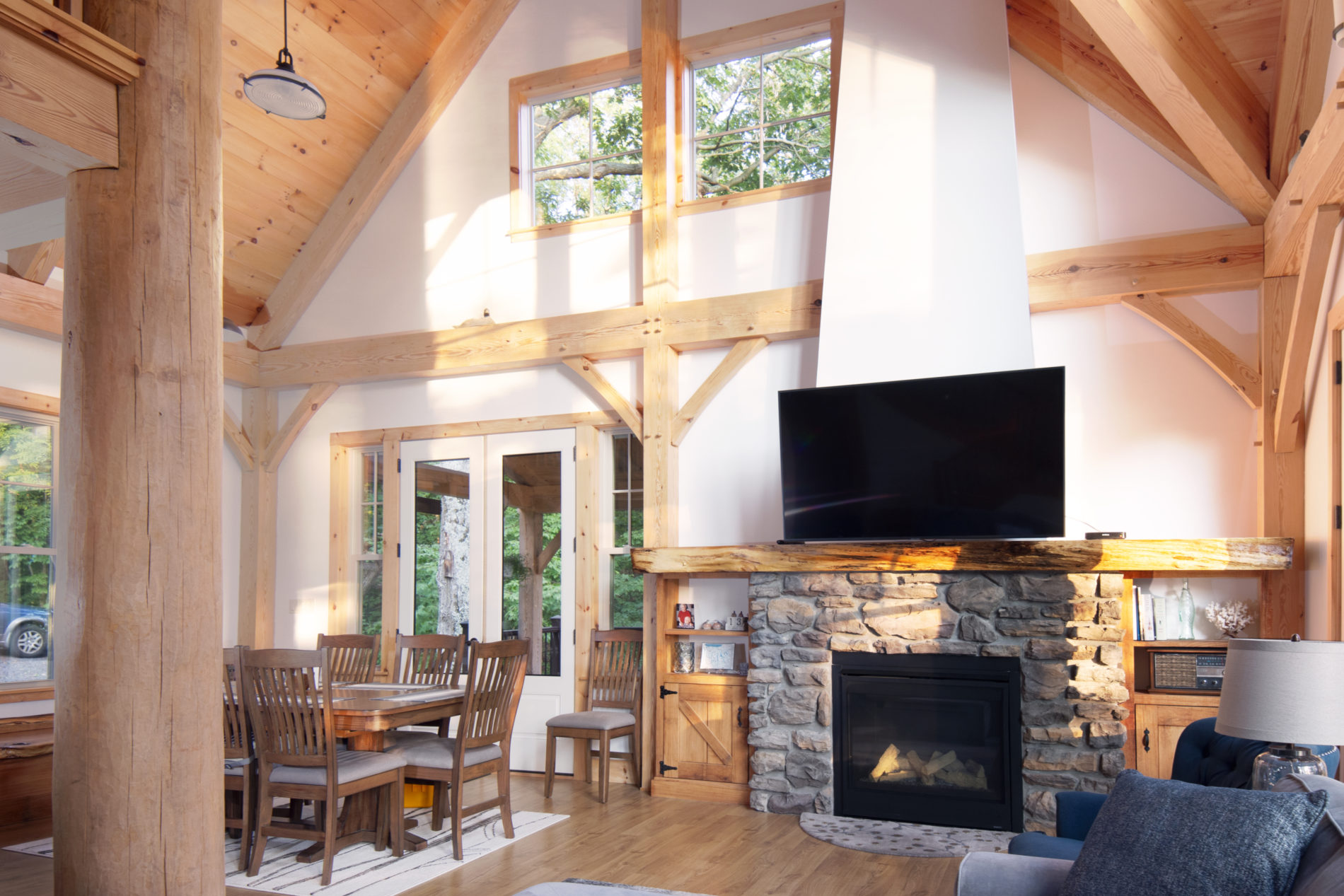
Stonework That Grounds It All
Stone adds more than structure. It brings dimension and a sense of place. Whether you imagine a rugged ledgestone fireplace, a smooth river rock accent wall, or a dry-stacked entryway, the right stonework anchors your home’s style and setting. Explore the our galleries to see even more examples of how stone and timber come together with intention, then connect with a design expert to craft a home that’s solid, striking, and uniquely yours.
Meet Woodhouse’s Experts
This post was reviewed by Pat Seaman. Pat is the owner and CEO of Woodhouse, The Timber Frame Company. He has personally built 7 timber frame homes and has been involved in many hundreds of timber frame projects over the last 22 years.

